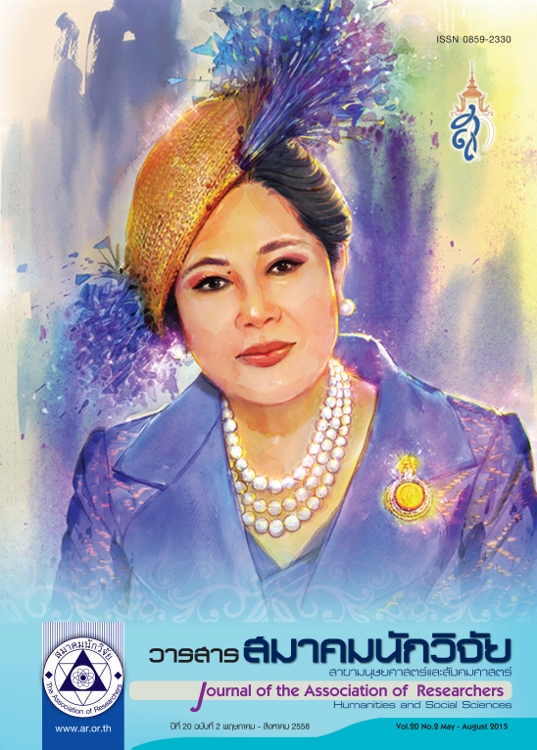Managerial Success with Four Iddhipada of Buddhist Monks for Buddhism Propagation in the Region of Uthaithani Province
Main Article Content
Abstract
The main objectives of this study were to investigate the managerial success, confirmatory factors, and causal relationships of the Managerial Success with Iddhipada 4 of Buddhist Monks (MS with I4BM) for Buddhism Propagation (BP) in the Region of Uthaithani Province (RUP). Data from 464 Monks of 293 Tamples qualitative questionnaires and the multi-stage random sampling were employed. All statistics were applied: frequency, percentage, means, standard deviation, one-sample t-test, confirmatory factor analysis, and path analysis. Research findings were as follows: 1) A whole of success and the belief aspect in Buddhism with the I4BM for BP, they were at the high level. On the contrary, three following aspects were at the low level, namely management, personality, and communication (p < .05); 2) Confirmatory components of the MS with I4BM for BP in terms of following aspects: personality, communication, management, belief in Buddhism, and successfulness, consisted of 3, 3, 7, 4, and 4 crucial components respectively; and 3) As a result of casual analysis with the model of the MS with I4BM for BP, it was found that all data were relevant with the model, statistics as Chi-square = 109.14, df = 184, P-value = 1.000, RMSEA = 0.000. Also, it was concluded that the model could be appropriately and could be explained as follows: the MS with I4BM for BP in RUP received direct effects from both crucial factors of Belief in Buddhism and Management at the low level. Also, it received an indirect effect from the personality factor at the moderate level through the factor of management or belief in Buddhism. All those could predict the MS with I4BM for BP at 45.10 percent and at the .05 level of significance.
Article Details
บทความที่ปรากฏในวารสารนี้ เป็นความรับผิดชอบของผู้เขียน ซึ่งสมาคมนักวิจัยไม่จำเป็นต้องเห็นด้วยเสมอไป การนำเสนอผลงานวิจัยและบทความในวารสารนี้ไปเผยแพร่สามารถกระทำได้ โดยระบุแหล่งอ้างอิงจาก "วารสารสมาคมนักวิจัย"
References
บุญมี บุญเอี่ยม. (2544). ศึกษาการนำอิทธิบาท 4 ไปใช้ในการทำงานของพนักงานศูนย์ควบคุมการบินภูเก็ต บริษัท วิทยุ การบินแห่งประเทศไทย จำกัด. วิทยานิพนธ์การศึกษามหาบัณฑิต มหาวิทยาลัยทักษิณ.
พระธรรมปิฎก (ป.อ. ปยุตฺโต). (2546). พจนานุกรมพุทธศาสตร์ ฉบับประมวลธรรม, พิมพ์ครั้งที่ 12. กรุงเทพมหานคร: มหาจุฬาลงกรณราชวิทยาลัย.
พระธรรมปิฎก (ป.อ. ปยุตฺโต). (2541). ธรรมนูญชีวิตพุทธจริยธรรมเพื่อชีวิตที่ดีงาม, พิมพ์ครั้งที่ 10. กรุงเทพมหานคร: สหธรรมิก.
พระธรรมโกศาจารย์ (ประยูร ธมฺมจิตฺโต). พุทธวิธีบริหาร. กรุงเทพฯ: มหาวิทยาลัยมหาจุฬาลงกรณราชวิทยาลัย. พระราชวรมุนี (ประยูร ธมฺมจิตฺโต). (2551). “คุณธรรมสำหรับนักบริหาร”. จริยธรรมสำหรับผู้บริหาร. กรุงเทพมหานคร: เอ็กซ์เปอร์เน็ท.
พระเทพวิสุทธิกวี (พิจิตร ฐิตวัณโณ). (2538). การพัฒนาจิต. กรุงเทพมหานคร: มหามกุฏราชวิทยาลัย. พุทธทาสภิกขุ. (2535). การเก็บความโกรธใส่ยุ้งฉาง, พิมพ์ครั้งที่ 5. นนทบุรี: พี.เองลิฟวิ่ง.
สมชาย พุทธโกสัย สุทธนู ศรีไสย์ และ จินต์ วิภาตะกลัศ. (2556). “คุณภาพการบริหารจัดการสถานศึกษาระดับ ประถมศึกษาในเขตตรวจราชการที่ 2 กระทรวงศึกษาธิการ,” วารสารสมาคมนักวิจัย, 18(2): 92-94.
สุทธนู ศรีไสย์. (2551). สถิติประยุกต์สำหรับงานวิจัยทางสังคมศาสตร์, พิมพ์ครั้งที่ 3. กรุงเทพมหานคร: จุฬาลงกรณ์ มหาวิทยาลัย.
Kline, R.B. (1998). Principles and practice of structural equation modeling, New York: Guild Press. Steiger, J.H. (1990). “Structural model evaluation and modification: An internal estimation approach.” Multivariate Behavioral Research, 25: 173-180.
Ullman, J.B. (2001). Structural equation modeling. In B.G. Tabachnick, and L.S. Fidell, Using Multivariate Statistics, (4th ed.), 653-771. New York: Allyn Bacon.


